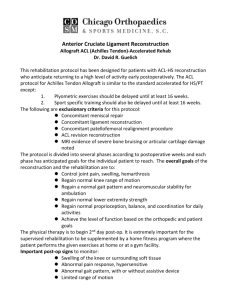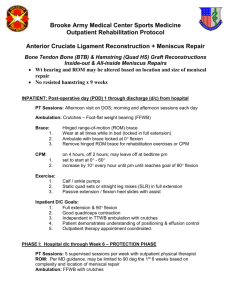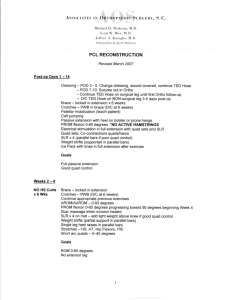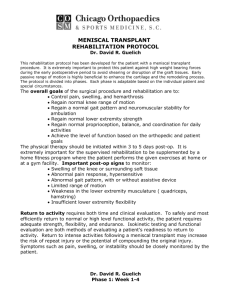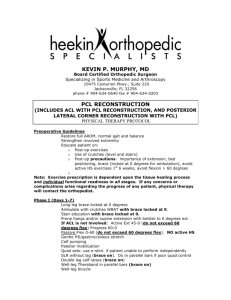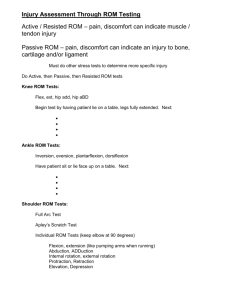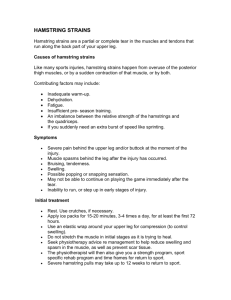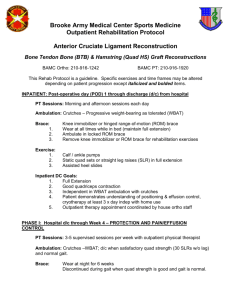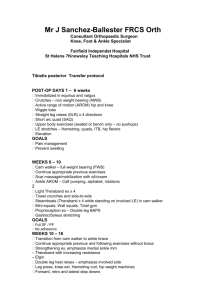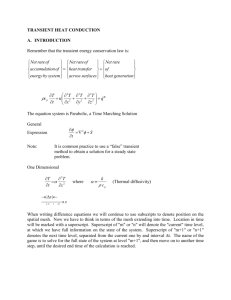Dr. David R. Guelich
advertisement
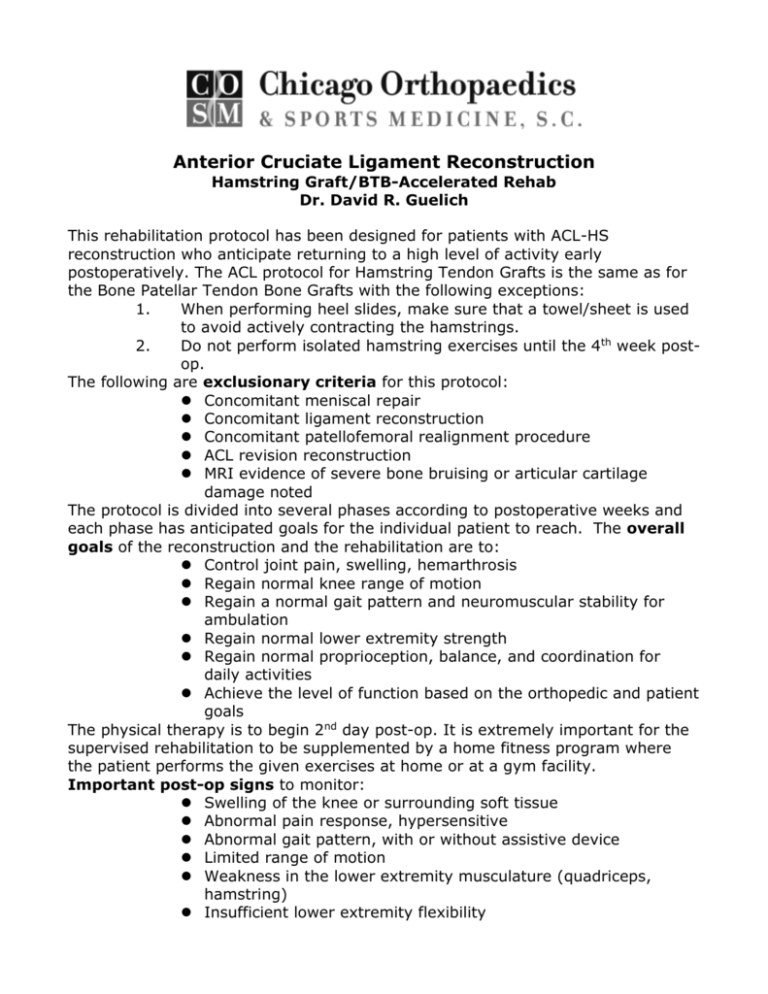
Anterior Cruciate Ligament Reconstruction Hamstring Graft/BTB-Accelerated Rehab Dr. David R. Guelich This rehabilitation protocol has been designed for patients with ACL-HS reconstruction who anticipate returning to a high level of activity early postoperatively. The ACL protocol for Hamstring Tendon Grafts is the same as for the Bone Patellar Tendon Bone Grafts with the following exceptions: 1. When performing heel slides, make sure that a towel/sheet is used to avoid actively contracting the hamstrings. 2. Do not perform isolated hamstring exercises until the 4th week postop. The following are exclusionary criteria for this protocol: Concomitant meniscal repair Concomitant ligament reconstruction Concomitant patellofemoral realignment procedure ACL revision reconstruction MRI evidence of severe bone bruising or articular cartilage damage noted The protocol is divided into several phases according to postoperative weeks and each phase has anticipated goals for the individual patient to reach. The overall goals of the reconstruction and the rehabilitation are to: Control joint pain, swelling, hemarthrosis Regain normal knee range of motion Regain a normal gait pattern and neuromuscular stability for ambulation Regain normal lower extremity strength Regain normal proprioception, balance, and coordination for daily activities Achieve the level of function based on the orthopedic and patient goals The physical therapy is to begin 2nd day post-op. It is extremely important for the supervised rehabilitation to be supplemented by a home fitness program where the patient performs the given exercises at home or at a gym facility. Important post-op signs to monitor: Swelling of the knee or surrounding soft tissue Abnormal pain response, hypersensitive Abnormal gait pattern, with or without assistive device Limited range of motion Weakness in the lower extremity musculature (quadriceps, hamstring) Insufficient lower extremity flexibility Return to activity requires both time and clinic evaluation. To safely and most efficiently return to normal or high level functional activity, the patient requires adequate strength, flexibility, and endurance. Isokinetic testing and functional evaluation are both methods of evaluating a patient’s readiness to return to activity. Dr. David R. Guelich Phase 1: Week 1-2 HS/PTG Accelerated Protocol WEEK 1-2 EXERCISE ROM Passive, 0-110 Patella mobs Ankle pumps Gastoc-soleus stretches Wall slides Heel slides with towel STRENGTH Quad sets x 10 minutes SLR (flex, abd, add) Multi-hip machine (flex, abd, add) Leg Press (90-20)-bilateral Mini squats (0-45) Multi-angle isometrics (90-60) Calf Raises BALANCE TRAINING Weight shifts (side/side, fwd/bkwd) Single leg balance Plyotoss WEIGHT BEARING Wt bearing as tolerated with crutches Crutches until quad control is gained One crutch before FWB with no crutches BICYCLE May begin when 110 flex is reached DO NOT use bike to increase flexion MODALITIES Electrical stimulation as needed Ice 15-20 minutes with knee at 0 ext BRACE Remove brace to perform ROM activities I-ROM when walking with crutches GOALS OF PHASE: ROM 0-110 Adequate quad contraction Control pain, inflammation, and effusion PWB TO FWB as capable GOAL 0-110 Dr. David R. Guelich Phase 2: Week 2-4 HS/PTG Accelerated Protocol WEEK 2-4 EXERCISE ROM Passive, 0-125 Patella mobs Ankle pumps Gastoc-soleus stretch Light hamstring stretch at wk 4 Wall, heel slides to reach goal STRENGTH Quad sets with biofeedback SLR in 4 planes (add ext at wk 4) Heel raise/Toe raise Leg Press Mini squat (0-45) Front and Side Lunges Multi-hip machine in 4 directions Bicycle/EFX Wall squats BALANCE TRAINING Balance board/2 legged Cup walking/hesitation walk Single leg balance Plyotoss WEIGHT BEARING As tolerated with quad control MODALITIES E-stim/biofeedback as needed Ice 15-20 minutes BRACE Will measure for functional Brace week 3-4 GOALS OF PHASE: Maintain full passive knee extension Gradually increase knee flexion to 125 Diminish pain, inflammation, and effusion Muscular strengthening and endurance Restore proprioception Patellar mobility GOAL 0-125 Discharge crutches 10 days post-op Discharge week 4 Dr. David R. Guelich Phase 3: Week 4-12 HS/PTG Accelerated Protocol WEEK 4-8 8-10 EXERCISE ROM GOAL Full ROM 0-135 Self-ROM to gain FROM And maintain 0 extension Gastoc/soleus stretching Hamstring stretching STRENGTH Progress isometric program SLR with ankle weight/tubing Leg Press-single leg eccentric Initiate isolated hamstring curls Multi-hip in 4 planes Lateral/Forward step-ups/downs Lateral Lunges Wall Squats Vertical Squats Heel raise/Toe raise Bicycle/EFX Retro Treadmill Mini-squats/Wall squats Straight-leg dead lifts Stool crawl BALANCE TRAINING Steam boats in 4 planes Single leg stance with plyotoss Wobble board balance work-single leg ½ Foam roller work MODALITIES Ice 15-20 minutes following activity BRACE Functional brace as needed ROM Full ROM Self-ROM as needed 0-135 Gastroc/Soleus/HS stretch STRENGTH Continue exercises from wk 4-6 Progress into jogging program as ROM normalizes, pain and swelling are minimal. Begin on mini-tramp, progress to treadmill as tolerated then hard surface when tolerated. Progress with proprioception training Isokinetic work (90-40)(120-240/sec) Dr. David R. Guelich Phase 3 cont…ACL-HS/PTG Protocol WEEK 8-10 cont 10-12 EXERCISE Walking program Bicycle for endurance Plyometric leg press/shuttle work ROM Gastroc/Soleus/HS stretch STRENGTH Continue exercises from wk 4-10 Isokinetic test at 180 and 300/sec Plyometric training drills Continue with stretching MODALITIES Ice 15-20 minutes as needed GOALS OF PHASE: Restore full knee ROM (0-135) Increase lower extremity strength and endurance Restore functional capability and confidence Enhance proprioception, balance, and neuromuscular control Phase 4: Week 12-16 HS/PTG Acceleration Protocol WEEK 12-16 EXERCISE ROM Continue all stretching activities STRENGTH Continue all exercises from previous phases Progress plyometric drills Increase jogging/running program Swimming (kicking) Backward running FUNCTIONAL PROGRAM Sport specific drills CUTTING PROGRAM Lateral movement Carioca, figure 8’s MODALITIES Ice 15-20 minutes as needed GOALS OF PHASE: Maintain muscular strength and endurance Enhance neuromuscular control Progress skill training Perform selected sport-specific activity Phase 5-Weeks 16-36 ACL-HS/PTG Protocol WEEK 16-36 EXERCISE STRENGTH Continue advanced strengthening FUNCTIONAL PROGRAM Progress running/swimming program Progress plyometric program Progress sport training program Progress neuromuscular program MODALITIES Ice 15-20 minutes as needed GOALS OF PHASE: Return to unrestricted sporting activity Achieve maximal strength and endurance Progress independent skill training Normalize neuromuscular control drills At six and twelve months, a follow-up isokinetic test is suggested to guarantee maintenance of strength and endurance. Advanced weight training and sports specific drills are advised to maintain a higher level of competition.
